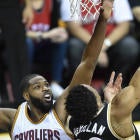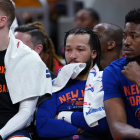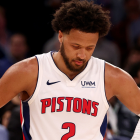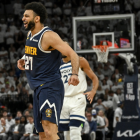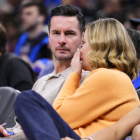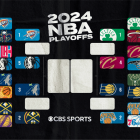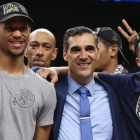Despite their shortcomings in the regular season, the Cleveland Cavaliers are still undefeated in the playoffs, having taken a 2-0 lead in their second-round series with a 125-103 win against the Toronto Raptors on Wednesday. As a result of a first-round sweep and a couple more convincing victories, the noise about their deficient defense is much quieter now. If they haven't flipped the proverbial switch, they have at least quelled concerns that the pressure of the postseason would quickly shine a light on their supposed Achilles' heel.
To be clear, Cleveland did not win Game 2 against the Raptors because of its defense. It won because it scored 99 points in three quarters. The Cavs shot 18 for 33 from 3-point range, and LeBron James had 39 points on 10-for-14 shooting (not a typo) in passing Kareem Abdul-Jabbar on the all-time playoff scoring list. Toronto once again looked helpless on defense, to the point where it was embarrassing.
Everyone knows Cleveland is awesome on offense, though. It employs James, Kyrie Irving and Kevin Love, plus some of the league's best shooters. Over the course of the season, the Cavs ranked third on offense and 22nd on defense. After the All-Star break, they were 29th on defense, worse than every team other than the lowly Los Angeles Lakers. This is not the typical profile of a championship contender.
In the playoffs, Cleveland has not transformed into a slow-it-down, defense-first outfit, but it has consistently executed its game plan. In projecting how it might fare if it returns to the NBA Finals, this might be the single most significant development.
Quick rewind: After the Cavs finished off the Indiana Pacers in four games, coach Tyronn Lue said he thought they were "really good" on defense. He credited Pacers guard Lance Stephenson for making shots and keeping his team in the game, but said Stephenson's open looks were part of the game plan because they wanted to "show Paul George a crowd."
George, Indiana's star, went 5-for-21 for 15 points in that elimination game. He had been brilliant in the three previous contests, but Cleveland decided it would do everything possible to shut him down and close the Pacers out. When George took a contested 3-pointer to try to tie it at the end of the fourth quarter, he missed it badly. He never established any sort of rhythm.
Lue's comments after taking a 2-0 lead against the Raptors were extremely similar. Toronto guard DeMar DeRozan, who averaged 27.3 points in the regular season (fifth in the league), scored five points on 2-for-11 shooting, and Lue made no mystery of his approach: He wanted to take the ball out of DeRozan's hands and make other guys make plays.
"We know DeMar is a great player and our strategy since I've been here the last three years is just take away what a team does the best," Lue said. "And we know he's a great scorer, so we're going to pay great attention to him. I give J.R. [Smith] a lot of credit, [Iman Shumpert] a lot of credit, LeBron a lot of credit, those guys are taking the challenge, but our bigs are doing a great job of doing the right coverage, doing the right rotations. At times, you're going to give up some plays."
This time, Raptors center Jonas Valanciunas was the stand-in for Stephenson. Valanciunas scored 19 of his 23 points in the first half on 9-for-10 shooting. In many ways, though, his production was a pyrrhic victory for Toronto.
When Valanciunas was scoring on the inside, the Raptors weren't getting offense from their stars or making 3-pointers. More importantly, Cleveland was targeting the slow-footed center on the other end possession after possession. It might have seemed like Toronto was making headway because the Cavs weren't stopping him, but Valanciunas was a minus-2 in his 13 first-half minutes and a minus-13 overall.
It felt similar to ex-Cleveland center Timofey Mozgov's 28-point performance in a 19-point loss when the Golden State Warriors started the Death Lineup for the first time in the 2015 NBA Finals. This time, it was the Cavs who were perfectly pleased to see the 7-footer stay out there, regardless of how many points he was scoring.
While Valanciunas and other role players were almost dared to shoot, DeRozan saw double-teams and traps all night. Mostly, he got rid of the ball, and he did so without committing a turnover. On the rare occasion that he forced his way to the basket, he was stonewalled by Cleveland big man Tristan Thompson:
For the Cavs, this is encouraging. They weren't perfect on defense; in fact, they still look slow at times and didn't defend the pick-and-roll particularly well. They took the Raptors out of their comfort zone, though, and that was their main objective. Kyle Lowry and DeRozan have been the driving force of their offense over the last few years, and DeRozan has taken on an even bigger load this season. Toronto coach Dwane Casey said the team can't survive if he doesn't make his presence felt.
"They're into him, bodying him," Casey said. "He's got to vault up and make his shots. I've got to do a better job of getting him open looks, which we're trying to do. But at the end of the day, we're going to go the way he and Kyle go. It's not like he's not working to do it, but we've gotta set better screens, he's gotta vault up and shoot the ball with conviction.
"They're not doing anything special," Casey continued. "They're blitzing on and off. He has another level he can get to."
DeRozan said he tried to make the right passes and trust his teammates, but acknowledged that the double-teams stopped him from getting himself going. Cleveland's defensive rating in the playoffs is still only average, but that doesn't come close to telling the whole story.
"You can't always think about the percentages," Lue said. "You gotta think about what you're trying to take away defensively, and make the team do something different that they [have] done all season. And that's our main focus."













